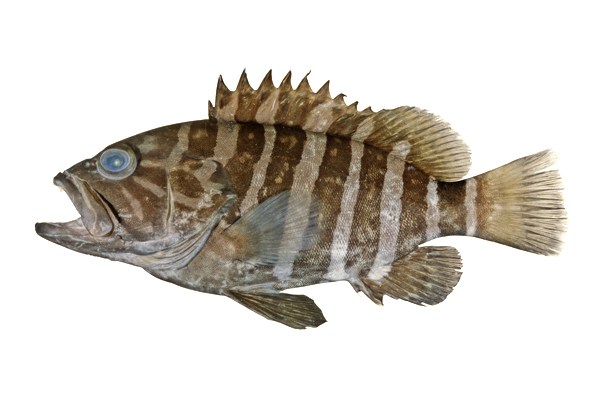- Classification
- ACTINOPTERYGII
- PERCIFORMES
- SERRANIDAE
- Hyporthodus
- griseofasciatus
Greybanded Grouper, Hyporthodus griseofasciatus Moore, Wakefield, DiBattista & Newman 2022
Other Names: Bar Rockcod, Convict Grouper, Convict Rockcod, Grey-banded Cod, Sevenband Grouper

Convict Grouper, Hyporthodus septemfasciatus. Source: Australian National Fish Collection, CSIRO. License: CC by Attribution-NonCommercial
Summary:
A deep-water grouper with seven broad dark brown bands of equal width alternating with grey bands along the body, a star-like pattern of five to eight dark-brown bands with grey interspaces radiating from the eye, and often a defined white margin on the caudal, dorsal and anal fins.
Cite this page as:
Bray, D.J. 2025, Hyporthodus griseofasciatus in Fishes of Australia, accessed 02 Jul 2025, https://fishesofaustralia.net.au/Home/species/5409
Greybanded Grouper, Hyporthodus griseofasciatus Moore, Wakefield, DiBattista & Newman 2022
More Info
|
Distribution |
Endemic to Western Australia, from Two Peoples Bay off the south coast, to Barrow Island in the northwest. |
|
Features |
Dorsal fin XI,14-15; Anal fin III,9; Pectoral fin 18-19, upper-most ray and lowermost ray unbranched, others branched; Pelvic fin I,5; Branched caudal-fin rays 9 + 8 = 17; Gill rakers first arch 8-9 + 14-15 = 23-24; Vertebrae 23; Lateral-line scales 57-77; Longitudinal scale series 101-134; Transverse scale rows below lateral line 24-36; Circum-peduncular scales 39-51. |
|
Feeding |
Feeds on small fishes and crustaceans. |
|
Biology |
A protogynous hermaphrodite which spawns in subtropical to tropical waters of the mid to upper west coast of Australia. The spawning period occurs over 5 months from late spring to summer (October–February. |
|
Fisheries |
Taken by commercial fishers and recreational anglers. |
|
Remarks |
This species was previously confused with Hyporthodus septemfasciatus, a species that occurs in Japan and the East China Sea (Moore et al. 2022). |
|
Similar Species |
Differs from Hyporthodus octofasciatus in having several of the grey bands being distinctly narrower than other grey bands (vs. all grey bands subequal in H. octofasciatus), and broad white margins on the dorsal, caudal and anal fins (vs. white margins narrow or absent in H. octofasciatus). |
|
Etymology |
The specific name is from the Latin griseo (= grey) and fasciatus (= banded), reflecting the unique vernacular name most frequently applied to this species by anglers in Western Australia, ‘greyband’, in reference to the grey colour of the pale bands. |
|
Species Citation |
Hyporthodus griseofasciatus Moore, Wakefield, DiBattista & Newman 2022, Journal of Fish Biology 1-17. Type locality: Two Peoples Bay canyon, Western Australia, 35 170 S, 118 050 E, 76 m depth. |
|
Author |
Bray, D.J. 2025 |
|
Resources |
Greybanded Grouper, Hyporthodus griseofasciatus Moore, Wakefield, DiBattista & Newman 2022
References
DiBattista, J.D., Wakefield, C.B., Moore, G. I., Bunce, M., et al. 2018. Genomic and life-history discontinuity reveals cryptic speciation and gene flow from tropical to temperate waters for a deep-water grouper lineage precinctive to West Australia. Ecological Genetics and Genomics 9: 23-33 https://doi.org/10.1016/j.egg.2018.09.001
Hutchins, J.B. & Thompson, M. 1983. The Marine and Estuarine Fishes of South-western Australia. Perth : Western Australian Museum 103 pp. 345 figs.
Moore, G.I., Wakefield, C.B., DiBattista, J.D. & Newman, S.J. 2022. Hyporthodus griseofasciatus (Perciformes: Epinephelidae), a new species of deep-water grouper from the west coast of Australia. Journal of Fish Biology 1-17 https://doi.org/10.1111/jfb.15231
Randall, J.E., Hoese, D.F. & Last, P.L. 1993. On the status of the Australian serranid fishes Epinephelus ergastularius Whitley and E. thompsoni Whitley. Records of the Australian Museum 45: 25-31
Yearsley, G.K., Last, P.R. & Ward, R.D. (eds) 1999. Australian Seafood Handbook. Hobart : CSIRO Marine Research 460 pp. (as Hyporthodus septemfasciatus)

